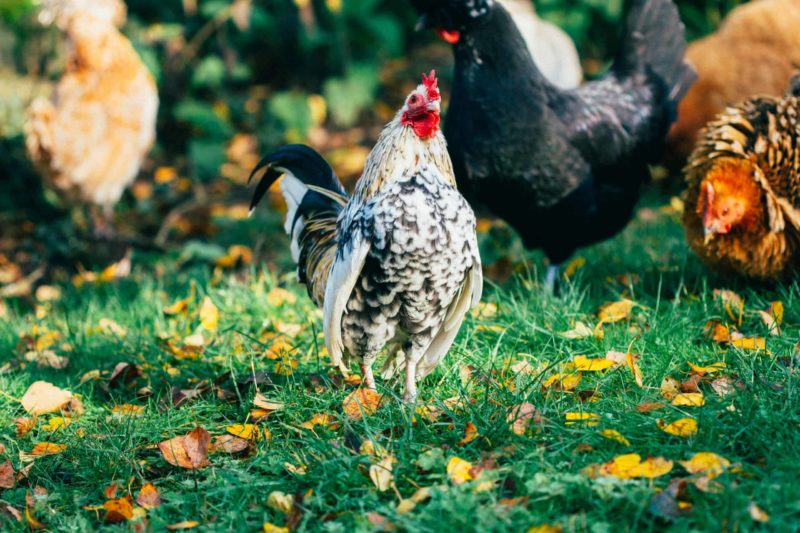
If you spend much time on sanctuary grounds, you likely know that residents have complex and fascinating personalities and quirks. Because many folks have likely never met individuals living out their lives in sanctuary before, we have created a series of resources compiling fun and fascinating facts about residents to share with supporters and the general public. Chickens are amazing beings who deserve to be better known!
Fun Facts About Chickens
- Did you know that most chickens (less so in large breedDomesticated animal breeds that have been selectively bred by humans to grow as large as possible, as quickly as possible, to the detriment of their health. chickens) choose to “work” for their food? This is called contra-freeloading. In some studies, chickens have chosen to press a button for food instead of eating from a readily available food source. They often enjoy puzzle feeders and scratching up their food from varied sources.
- You might not think it, but chickens have a great sense of smell. In fact, while there are limited studies on specific scents, scientists have found that chickens find vanilla to be a non-offensive scent and new chickens can be more calmly introduced into a pre-existing flock if each space has been provided vanilla leading up to and during the integration of a new flock member. In other chicken smell facts, geraniol has been shown to increase activity in chicks, while garlic tends to be avoided by chickens.
- It’s not all black and white in a chicken’s world. In fact, chickens are able to see more colors than humans! While the human retina contain cones that are sensitive to wavelengths of red, blue and green, chickens have an additional cone that can detect violet wavelengths, including some ultraviolet wavelengths!
- Not only do chickens see more colors than humans, but they have also demonstrated keen interest in images! They tend to prefer color images over black and white images, moving images over stationary images, more complex computer screensavers over a simple bouncing ball, and cartoons over screensavers. They become disinterested after a time in the same video, but will show renewed interest if shown a new video.
- Other amazing ocular abilities include the ability for chickens to focus close up AND far away at the same time in different areas of their field of vision!
- This may not surprise you, but hens are quite concerned for the well-being of their chicks, and will become distressed in the presence of something that may negatively affect their chicks, or if their chicks show signs of distress.
- Chickens have demonstrated the ability to understand that an object or individual still exists even when it or they are out of sight. This is something that human babies develop over time. In fact, five week old chicks demonstrated the ability to discern between larger numbers of objects and companions. This indicates an ability to count to a certain extent!
- Hens have demonstrated the ability to anticipate future outcomes based on sound recognition. For example, the sound of a storage container means breakfast, while the sound of leaves in a tree is a neutral sound, and the sound of a hawk can indicate negative outcomes.
- The end of a chicken’s beak (the bill tip organ) is composed of clusters of highly sensitive receptors which allow them to discriminate between all manner of textures and substances and objects. Talk about a brilliant beak!
- Roosters will make little “tut tut tut” sounds to let hens know they have found a source of food, and can be observed doing a little “tidbitting” dance, where they move their head up and down and pickup and drop food. They will often watch on as the hens eat their fill before joining in themselves. (Though we have definitely seen roosters without such manners!)
- While it might just sound like a bunch of clucking to an unfamiliar observer, chicken “language” consists of at least 24 different vocalizations! This doesn’t even include how they communicate through visual displays.
- Although we may have difficulty telling individuals of similar size and coloring apart, chickens can easily recognize individuals with their flock and remember their place in the social hierarchy (also known as the pecking order).
Hopefully this gives you and your visitors a better idea about the complex and fascinating lives of chickens. Did you find any of these fun facts surprising? Or would you like to see a verified fun chicken fact added to this list? Let us know!
Fun Facts About Chickens Infographic
Looking to share this information in an accessible way with other sanctuaries and supporters? Check out and share our infographic below!
SOURCES:
The Inner Lives Of Chickens: Intelligence, Self-Control And Empathy | World Animal Protection
Thinking Chickens: A Review Of Cognition, Emotion, And Behavior In The Domestic Chicken | Animal Cognition (Written by a compassionate scientist, published in a Non-Compassionate Source and drawing from some Non-Compassionate studies.)
Poultry Behaviour and Welfare | Google Books (Non-Compassionate Source)
Discrimination Of Group Members By Laying Hens Gallus Domesticus | Behavioural Processes (Non-Compassionate Source)
Avian Maternal Response To Chick Distress | Proceedings. Biological Sciences / The Royal Society (Non-Compassionate Source)
Fun Facts About Chickens by Amber D Barnes
If a source includes the (Non-Compassionate Source) tag, it means that we do not endorse that particular source’s views about animals, even if some of their insights are valuable from a care perspective. See a more detailed explanation here.








